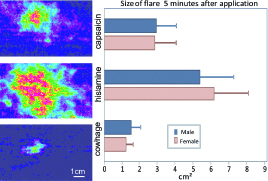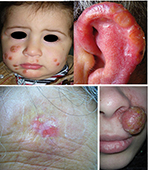Content - Volume 95, Issue 1
You can find all new content after October 1 on our new website, you can find it
here.
Editor's choice in this issue
REVIEW
Bodo C. Melnik

This review presents recent evidence of impaired Notch signalling in atopic dermatitis (AD), which is proposed to represent the “a-topic” defect linking both epidermal and immunological barrier dysfunctions in AD. AD epidermis exhibits a marked deficiency of Notch receptors. Mouse models with genetically suppressed Notch signalling exhibit dry skin, signs of scratching, skin barrier abnormalit ...
Pages: 5-11
INVESTIGATIVE REPORT
Elisabeth M. Hartmann, Herman O. Handwerker, Clemens Forster

Cowhage, capsaicin and histamine, all applied via spicules, were used to induce itch and pain-related sensations in 15 male and 15 female subjects. Sensory qualities were assessed by questionnaire; intensities and time courses of the “itching” and “burning” sensation were measured alternately, but continuously on a VAS. In addition, axon reflexes were assessed. Only histamine and capsaicin ...
Pages: 25-30
CLINICAL REPORT
Kinan Hayani, Anwar Dandashli, Elke Weisshaar

Cutaneous leishmaniasis (CL) is a worldwide disease caused by an infection with the protozoan parasite Leishmania transmitted via sand flies. It is endemic in many of the poorest countries of all continents. “Aleppo boil” is one of the recognised names given to this disease in the medical literature. Although CL used to be well-controlled and well-documented in Syria, its incidence has dramati ...
Pages: 62-66
All articles
COMMENTARY
Joanna M. Fawcett, Roderick J. Hay
Abstract is missing (Commentary)
Pages: 3-4
REVIEW
Bodo C. Melnik
This review presents recent evidence of impaired Notch signalling in atopic dermatitis (AD), which is proposed to represent the “a-topic” defect linking both epidermal and immunological barrier dysfunctions in AD. AD epidermis exhibits a marked deficiency of Notch receptors. Mouse models with genetically suppressed Notch signalling exhibit dry skin, signs of scratching, skin barrier abnormalit ...
Pages: 5-11
SPECIAL REPORT
Marianne Hald, Maiken C. Arendrup, Else L. Svejgaard, Rune Lindskov, Erik K. Foged, Ditte Marie L. Saunte
Internationally approved guidelines for the diagnosis and management of Malassezia-related skin diseases are lacking. Therefore, a panel of experts consisting of dermatologists and a microbiologist under the auspices of the Danish Society of Dermatology undertook a data review and compiled guidelines for the diagnostic procedures and management of pityriasis versicolor, seborrhoeic dermatitis and ...
Pages: 12-19
INVESTIGATIVE REPORT
Yoon Seok Yang, Soo Ick Cho, Min Gyu Choi, Young Hee Choi, In Suk Kwak, Chun Wook Park, Hye One Kim
Post-burn pruritus is a common distressing consequence of burn wounds. Empirical treatment often fails to have a satisfactory outcome on post-burn pruritus, as the mechanism of post-burn pruritus has not been fully elucidated. The aim of this study was to evaluate the manifestation of transient receptor potential (TRP) channels in post-burn pruritus. Fifty-one burn patients with (n=33) or without ...
Pages: 20-24
INVESTIGATIVE REPORT
Elisabeth M. Hartmann, Herman O. Handwerker, Clemens Forster
Cowhage, capsaicin and histamine, all applied via spicules, were used to induce itch and pain-related sensations in 15 male and 15 female subjects. Sensory qualities were assessed by questionnaire; intensities and time courses of the “itching” and “burning” sensation were measured alternately, but continuously on a VAS. In addition, axon reflexes were assessed. Only histamine and capsaicin ...
Pages: 25-30
INVESTIGATIVE REPORT
Marléne Isaksson, Inese Hauksson, Monica Hindsén, Ann Pontén, Cecilia Svedman, Magnus Bruze
The preservative methylchloroisothiazolinone/methylisothiazolinone (MCI/MI) is a well-known sensitiser and present in most baseline series since at least 20 years. The proportions of MCI/MI are 3:1. MI alone has been used as a preservative in occupational and household products, and cosmetics since less than 10 years. MCI/MI tested at 100 ppm fails to detect a significant percentage of contact-all ...
Pages: 31-34
INVESTIGATIVE REPORT
Niccolò Nami, Cesare Massone, Pietro Rubegni, Gabriele Cevenini, Michele Fimiani, Rainer Hofmann-Wellenhof
Smartphones have overcome the limitations of image quality seen in older devices and opened a new field of telemedicine called “mobile teledermatology”. Technological advances and the need to reduce health service costs will strongly promote the development of telemedicine. For this reason, we evaluated the concordance between store-and-forward mobile teledermatology and the classical face-to- ...
Pages: 35-39
INVESTIGATIVE REPORT
Elena Campione, Emanuela Medda, Evelin J. Paternò, Laura Diluvio, Ilaria Ricozzi, Isabella Carboni, Gaetana Costanza, Piero Rossi, Cristina Rapanotti, Alessandro Di Stefani, Sergio Chimenti, Luca Bianchi, Augusto Orlandi
The detoxifying enzyme glutathione–s–transferase pi (GST–π) is present in keratinocytes and melanocytes and exerts a protective role against tumour progression. Melanomas close to melanocytic naevus remnants occur less frequently on sun-exposed areas, whereas solar dermal elastosis, hallmark of chronic sun-damage, characterise melanomas on sun-exposed skin. We evaluated the expression o ...
Pages: 40-44
INVESTIGATIVE REPORT
Josep Malvehy, Rodrigo Roldán-Marín, Pablo Iglesias-García, Alba Díaz, Susana Puig
Visual inspection may fail to accurately evaluate field cancerisation (subclinical actinic keratoses [AKs]). We aimed to describe field cancerisation by confocal reflectance microscopy and changes induced by the application of 3% diclofenac sodium gel in 2.5% hyaluronic acid. Fourteen male patients, >50 years old, with AKs on the bald scalp were included. Clinical examination, confocal microscopy ...
Pages: 45-50
INVESTIGATIVE REPORT
Oda D. van Cranenburgh, Ellen M.A. Smets, Menno A. de Rie, Mirjam A.G. Sprangers, John de Korte
Chronic skin diseases have a negative impact on patients’ health-related quality of life (HRQoL). Patient education might contribute to HRQoL improvement. We developed a web-based, educational, HRQoL intervention for patients with a chronic skin disease. We aimed to assess 1) the feasibility of implementing the intervention in routine dermatological practice and patients’ daily life, and 2) th ...
Pages: 51-56
CLINICAL REPORT
Giuseppe Micali, Dagmar Wilsmann-Theis, Lotus Mallbris, Gaia Gallo, Valentina Marino, Yves Brault, Jean-Michel Germain
Cyclosporine is an established therapy for psoriasis that provides rapid relief of symptoms but has long-term toxic side effects. The objective of this study was to demonstrate the efficacy of etanercept as replacement therapy for cyclosporine in patients with moderate-to-severe plaque psoriasis. Patients with plaque psoriasis were given cyclosporine 5 mg/kg/day until achievement of PASI50 at whic ...
Pages: 57-61
CLINICAL REPORT
Kinan Hayani, Anwar Dandashli, Elke Weisshaar
Cutaneous leishmaniasis (CL) is a worldwide disease caused by an infection with the protozoan parasite Leishmania transmitted via sand flies. It is endemic in many of the poorest countries of all continents. “Aleppo boil” is one of the recognised names given to this disease in the medical literature. Although CL used to be well-controlled and well-documented in Syria, its incidence has dramati ...
Pages: 62-66
CLINICAL REPORT
Michael Trapp, Josef Wilhelm Egger, Hans-Peter Kapfhammer, Eva-Maria Trapp, Peter Michael Rohrer, Nina Hörlesberger, Gerold Schwantzer, Peter Komericki, Michael Dennis Linder, Andrey Lvov, Johannes Baulmann, Erika Richtig
An observational, exploratory, cross-sectional study was performed to assess whether the presence of atypical naevi (AN) in adolescents is associated with psychological and psychovegetative stress parameters. Fifty-one students of a secondary school in Graz, Austria, completed a defined test procedure consisting of an initial period of rest, a standardised mental stress task, another period rest a ...
Pages: 67-71
CLINICAL REPORT
Anne Kogge, Christelle Volteau, Mélanie Saint-Jean, Lucie Peuvrel, Anabelle Brocard, Anne-Chantal Knol, Jean-Jaques Renaut, Brigitte Dréno, Gaëlle Quéreux
Since the approval of vorinostat for the treatment of refractory cutaneous epidermotropic T-cell lymphoma (CTCL) in 2006, very little data about this treatment have been published. The aim of this retrospective study was to assess the efficacy and safety of vorinostat in patients with CTCL treated between 2007 and 2013 in our department. Fifteen patients (median age 64 years) were included: 9 with ...
Pages: 72-77
CLINICAL REPORT
Olivia Boccara, Cecile Méni, Christine Léauté-Labreze, Christine Bodemer, Jean-Jacques Voisard, Hélène Dufresne, Sébastien Brauchoux, Charles Taieb
To develop and validate a specific questionnaire to assess burden on families of children with infantile haemangioma (IH): the Haemangioma Family Burden questionnaire (HFB). Items were generated from a literature review and a verbatim report from parents. Subsequently, a study was implemented at the Necker Hospital and the Pellegrin Children’s Hospital for psychometric analysis. The HFB was refi ...
Pages: 78-82
CLINICAL REPORT
Gudula Kirtschig, Tim van Meurs, Remco van Doorn
Topical imiquimod cream is increasingly applied in the treatment of lentigo maligna (LM), in particular for large lesions where surgery may lead to disfiguring scars. Published studies suggest that more frequent and prolonged treatment with topical imiquimod is associated with
higher efficacy. In this study we prospectively treated 27 patients suffering from LM on the face with imiquimod 5% cream ...
Pages: 83-85
CLINICAL REPORT
Amit Aakash Shah, Kristina Seiffert-Sinha, David Sirois, Victoria P. Werth, Badri Rengarajan, William Zrnchik, Kristopher Attwood, Animesh A. Sinha
Pemphigus vulgaris (PV) is a rare, potentially life threate-ning, autoimmune blistering skin disease. The International Pemphigus and Pemphigoid Foundation (IPPF) has recently developed a disease registry with the aim to enhance our understanding of autoimmune bullous diseases with the long-term goal of acquiring information to improve patient care. Patients were recruited to the IPPF disease regi ...
Pages: 86-90
SHORT COMMUNICATION
Tao Liu, Ge Qian, Xiao Xia Wang, Yan Guo Zhang
Abstract is missing (Short Communication)
Pages: 91-92
SHORT COMMUNICATION
Ayaka Ohzono, Sanae Numata, Takahiro Hamada, Shunpei Fukuda, Kwesi Teye, Yusuke Shirakashi, Hiroko Kasai, Hiroshi Koga, Norito Ishii, Makoto Sugiura, Takashi Hashimoto
Abstract is missing (Short Communication)
Pages: 93-94
SHORT COMMUNICATION
Tasuku Sano, Akane Minagawa, Hiroshi Koga, Hisashi Uhara, Ryuhei Okuyama
Abstract is missing (Short Communication)
Pages: 95-96
SHORT COMMUNICATION
Christoffer Gebhardt, Janina Staub, Astrid Schmieder, Sergij Goerdt, Jochen Utikal
Abstract is missing (Short Communication)
Pages: 96-97
SHORT COMMUNICATION
Yuki Mizuno, Genichi Kato, En Shu, Hidenori Ohnishi, Toshiyuki Fukao, Osamu Ohara, Hitomi Fukumoto, Harutaka Katano, Mariko Seishima
Abstract is missing (Short Communication)
Pages: 98-99
SHORT COMMUNICATION
Noriko Shimoura, Atsushi Fukunaga, Hiroshi Nagai, Masahiro Oka, Chikako Nishigori
Abstract is missing (Short Communication)
Pages: 100-101
SHORT COMMUNICATION
Wojciech Baran, Aleksandra Batycka-Baran, Joanna Maj, Jacek C. Szepietowski
Abstract is missing (Short Communication)
Pages: 102-103
SHORT COMMUNICATION
Chester Lai, Ciara Haddadeen, Shin-Young Cho, Adam Fityan, Andrew Bates, Jeffrey Theaker, Eugene Healy
Abstract is missing (Short Communication)
Pages: 104-105
SHORT COMMUNICATION
Noriki Fujimoto, Katsuyuki Kito, Takashi Yoshida, Toshihiro Tanaka
Abstract is missing (Short Communication)
Pages: 106-107
SHORT COMMUNICATION
Valérie Tauveron, Stéphanie Bourdu, Christelle Barbet, Anne de Muret, Martine Burgot, Franck Desmidt, Loïc Vaillant, Laurent Machet
Abstract is missing (Short Communication)
Pages: 108-109
SHORT COMMUNICATION
Toshifumi Nomura, Akihiro Yoneta, Elizabeth Pohler, Shotaro Suzuki, Rinko Osawa, Osamu Mizuno, Yuka Ohguchi, Yukiko Nomura, Toshiharu Yamashita, W.H. Irwin McLean, Hiroshi Shimizu
Abstract is missing (Short Communication)
Pages: 110-111
SHORT COMMUNICATION
Mingyang Lee, Quan Chen, Huijun Wang, Jie Zhang, Zhimiao Lin, Yong Yang
Abstract is missing (Short Communication)
Pages: 112-113
SHORT COMMUNICATION
Elyse M. Love, Gerardo A. Marrazzo, Seema Kini, Emir Veledar, Suephy C. Chen
Abstract is missing (Short Communication)
Pages: 114-115
SHORT COMMUNICATION
Rina Segal, Marina Eskin-Schwartz, Akiva Trattner, Meora Feinmesser, Emmilia Hodak, Arieh Ingber, Michael David
Abstract is missing (Short Communication)
Pages: 116-117
LETTER TO THE EDITOR
Peter D. Baade, Danny R. Youlden, Philippa Youl, Michael Kimlin, Craig Sinclair, Joanne Aitken
Abstract is missing (Letter to the Editor)
Pages: 118-120
QUIZ
Francesco Lacarrubba, Franco Dinotta, Anna Elisa Verzì, Maria Letizia Musumeci, Giuseppe Micali
Abstract is missing (Quiz)
Pages: 121-123
QUIZ
Charles B. Kromann, Kian Zarchi, Birgit M. Nürnberg, Gregor B.E. Jemec
Abstract is missing (Quiz)
Pages: 121-123
BOOK REVIEW
Jacek Szepietowski
Abstract is missing (Book review)
Page: 124
BOOK REVIEW
Arne Wikström
No Abstract available (Book review)
Page: 124
BOOK REVIEW
Regina Fölster-Holst
Abstract is missing (Book review)
Page: 125


